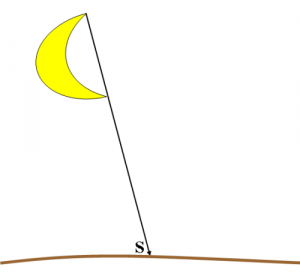The moon has no light of its own. The light seen from the moon is a reflection of the sun. The shape of the reflected light varies as the Earth orbits around the sun. This can be useful for finding direction at night once you understand how this works. When it is a crescent moon, it is straightforward.
To Find South during a Crescent Moon
- Imagine a line connecting the endpoints of the moon’s crescent projecting to the horizon.
- The point on the horizon indicates South. If you are in the Southern Hemisphere, such as Australia or New Zealand, this point is North.
To Find East-West
- If the moon rises before the sun sets, the illuminated side is West.
- If the moon rises after midnight, the illuminated side is East.
Although the example above is for the Northern Hemisphere (a significant portion of land is here), it also works if you are in the Southern Hemisphere.
This navigational method works because the sun moves across the sky from east to west. Since the moon reflects the sun’s light, its bright side will be ‘pointing’ to the direction of the sun, or approximately east or west.
Moon Trivia (North Hemisphere)
When the moon moves away from the sun’s glare and out of the earth’s shadow, the moon reflects light from the right side and waxes to become a full moon. The right portion of the moon is continually growing (i.e., if the right side is dark, the moon is getting darker; if the right side is lit, the moon is growing lighter). After the full moon, it starts to wane or lose shape and reflects light as a sliver on the left side.
- The New Moon or No Moon always rises at sunrise. It’s invisible because its illuminated side faces away from the earth. Directional navigation won’t be possible because it’s too close to the sun’s glare to be visible.
- The Crescent Moon follows the New Moon. It will appear just after sunset in the western sky.
- The Waxing Crescent Moon waxes to become a full moon. It reflects light from the right side as it moves away from the earth’s shadow. The right 1-49% is visible.
- The First quarter moon rises at noon. The right 50% is now visible. The illuminated side is West.
- The Full Moon rises at sunset. The entire 100% of the moon is visible.
- The Waning crescent moon wanes (loses shape) to become a new moon. The left 1-49% is visible.
- The Last Quarter moon rises at midnight. The left 50% is visible.


2 thoughts on “Directional Navigation Using the Moon”
Good stuff. I’ve printed this off and will take it into the mountains to see how it correlates with Southern Hemisphere data.
If one know the face of the Moon, he may use that to tell its direction. It rolls across the sky from east to west, clockwise if one be north of the Tropic of Capricorn, & anticlockwise of one be South of the Tropic of Cancer. Thus, one may see if it be in the ESE, or the ENE, or whatever. The rises with its east face, & sets with its west face. Ignore the telescope gazers’ directions, changed to suit them, in 1961.